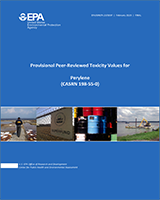3.1. DERIVATION OF PROVISIONAL REFERENCE DOSES
No studies were located regarding toxicity of perylene to humans or animals via oral exposure. Due to the lack of oral toxicity data for perylene, subchronic and chronic provisional reference doses (p-RfDs) were not derived directly. Instead, screening subchronic and chronic p-RfDs are derived in Appendix A using an alternative analogue approach. Based on the overall analogue approach presented in Appendix A, BaP was selected as the most appropriate analogue for perylene for deriving screening subchronic and chronic p-RfDs (see Table 5).
Table 5
Summary of Noncancer Reference Values for Perylene (CASRN 198-55-0).
3.2. DERIVATION OF PROVISIONAL REFERENCE CONCENTRATIONS
No studies were located regarding toxicity of perylene to humans or animals via inhalation exposure. Due to the lack of inhalation toxicity data for perylene, subchronic and chronic provisional reference concentrations (p-RfCs) were not derived directly. Instead, screening subchronic and chronic p-RfCs are derived in Appendix A using an alternative analogue approach. Based on the overall analogue approach presented in Appendix A, BaP was selected as the most appropriate analogue for perylene for deriving screening subchronic and chronic p-RfCs (see Table 5).
3.3. SUMMARY OF NONCANCER SCREENING PROVISIONAL REFERENCE VALUES
The noncancer screening provisional reference values for perylene are summarized in Table 5.
3.4. CANCER WEIGHT-OF-EVIDENCE DESCRIPTOR
Although the scientific literature provides limited information on the mutagenicity and genotoxicity of perylene, no oral or inhalation studies have been conducted to assess its carcinogenicity. Available dermal studies and a single i.p. carcinogenicity study provide limited evidence of carcinogenic potential; the relevance of these findings to oral or inhalation exposure is unclear. Under the U.S. EPA Cancer Guidelines (U.S. EPA, 2005), there is “Inadequate Information to Assess Carcinogenic Potential” of perylene by oral or inhalation exposure (see Table 6).
Table 6
Cancer WOE Descriptor for Perylene (CASRN 198-55-0).
- DERIVATION OF PROVISIONAL VALUES - Provisional Peer-Reviewed Toxicity Values for...DERIVATION OF PROVISIONAL VALUES - Provisional Peer-Reviewed Toxicity Values for Perylene (CASRN 198-55-0)
- REVIEW OF POTENTIALLY RELEVANT DATA (NONCANCER AND CANCER) - Provisional Peer-Re...REVIEW OF POTENTIALLY RELEVANT DATA (NONCANCER AND CANCER) - Provisional Peer-Reviewed Toxicity Values for Perylene (CASRN 198-55-0)
- Homo sapiens protein phosphatase 1 regulatory subunit 8 (PPP1R8), transcript var...Homo sapiens protein phosphatase 1 regulatory subunit 8 (PPP1R8), transcript variant 1, mRNAgi|1519245064|ref|NM_014110.5|Nucleotide
- Mus musculus glutamic-oxaloacetic transaminase 1, soluble (Got1), mRNAMus musculus glutamic-oxaloacetic transaminase 1, soluble (Got1), mRNAgi|160298208|ref|NM_010324.2|Nucleotide
- PREDICTED: Pteropus alecto DnaJ heat shock protein family (Hsp40) member B6 (DNA...PREDICTED: Pteropus alecto DnaJ heat shock protein family (Hsp40) member B6 (DNAJB6), transcript variant X3, mRNAgi|1387520643|ref|XM_025044877.1|Nucleotide
Your browsing activity is empty.
Activity recording is turned off.
See more...
